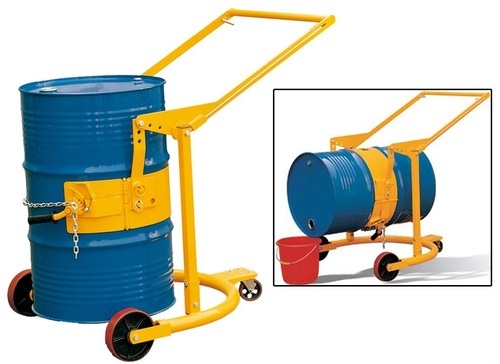Oil drums are notoriously heavy when full, and cumbersome and difficult to manoeuvre even when empty. Luckily, there are several manual handling solutions available for businesses that use these storage containers, as well as some well-established best practice techniques that should be adopted. Here is our guide to moving oil drums safely.
Dollies
Rolling a full oil drum is ill-advised – you can easily damage the drum and end up spilling the contents. Oil spills are notoriously difficult to clean up and can be very hazardous to the environment if they reach the water table. You need to use an oil drum dolly to move your oil drums (ideally even the empty ones, so you don’t damage the drum before it is re-used) – and you have a few options.
You can use a standard, square dolly to move your oil drum. The benefits here are that these dollies are multi-purpose – you can use them to move a whole range of items up to the weight capacity. Unfortunately, though, you’ll need to make sure that the oil drum is perfectly centred to ensure a safe move, and most basic models don’t come with handles, so you’ll be maneuvering the unit by way of the drum itself – which can cause it to tip over if it isn’t centered or if you hit a divot or other obstacle for the wheels.
The best type of dolly to use for moving oil drums is a purpose-built one. These typically have circular platforms with retaining lips to ensure that the drum is perfectly secure and stable, and higher-quality models will also have a handle for easy maneuverability. Be sure to get the dolly that fits your oil drums – standard-sized drums are 205 liter models, but there are other sizes on the market.
PPE
Personal protective equipment (PPE) is an important first step. At a minimum, the employee moving the drum will need a thick pair of gloves (riggers’ gloves, for example), to ensure their hands are protected. The contents of the drum will inform additional protective measures – if the contents are caustic, for example, make sure they wear goggles and maybe even gauntlets/overalls. For standard oil (the substance the drums are made for), gloves will often be sufficient.
When you are deciding on appropriate PPE, you need to think about the act of manipulating the drum, and also the potential of it dropping and bursting, or otherwise leaking.
Assess
Next, the person moving the drum needs to check it – make sure that it is not leaking, damaged, dented, corroded, etc, and that the lid is secured. Also, they need to be aware of what is inside so they can ensure they are treating it with the appropriate care and attention and moving it to a safe storage place.
As part of the pre-move assessment, it is good practice to check the route the drum will be taking. Make sure it is clear of any obvious hazard, and that any bumps, steps, dips or sharp turns are planned into the move.
Is a freelance tech writer based in the East Continent, is quite fascinated by modern-day gadgets, smartphones, and all the hype and buzz about modern technology on the Internet. Besides this a part-time photographer and love to travel and explore. Follow me on. Twitter, Facebook Or Simply Contact Here. Or Email: [email protected]

![23 Best Football Streaming Apps Free on Android [2023]. [All Leagues Streaming] Apps to Watch Live Football Matches](https://axeetech.com/wp-content/uploads/2022/11/Apps-to-Watch-Live-Football-Matches-1.jpg)





Leave a Reply